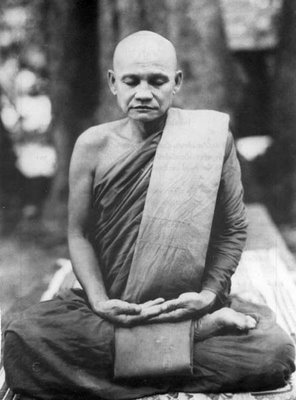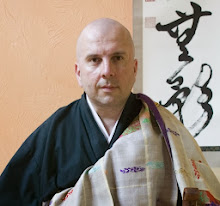
San-e. In Buddhism and according to the most ancient texts, every monk or nun has to wear three different kesas.
The anda-e ( in Chinese: an to hui, in Sanskrit; antarvasas). It is also called tan-e: simple clothing, ge-e: lower garment, gojo-e: five stripes robe…
The uddara-e ( Ch: yu to long seng, Sans: uttarasamga)
The sonyari-e ( Ch: seng chia ti li, San: samghati)
In Theravada, the monk wears three robes one on the top of another. The first one ( antarvasas) is a kind of underwear and is wrapped around the waist. The uttarasamga is unfolded on the left shoulder and the samghati is used as a coat.
Originally, the anda-e was seldom used. According to the Vinayas, a monk could wear it if he was on his own, sick,crossing a river or looking for a new kesa. Later on, in China, other clothings were introduced and gradually the anda-e stopped being a kind of underwear. Monks started to wear it on the top. This robe has changed a lot, and the rakusu that we all know well is one of its forms ( the two other kinds of anda-e in Zen the Okau, large rakusu that one wears on the left shoulder and the hangesa , “half kesa” that is given to lay people).
The uddara-e is also known as the shichijo-e, robe of seven stripes, each panel being made of two long segments and a short one. It is the monk’s kesa, it is used for sitting, taking meals, rituals.
The dai-e, is the big robe. It can be made of nine, eleven, thirteen, fifteen, seventeen, nineteen, twenty-one, twenty three or twenty five stripes. It is used for rituals and ritual begging (takuhatsu).
The rule is for monks and nuns to always have the three kesas with them. That’s why we have now a set of three small kesas called “shosanne”. In Japan, all the disciples of kodo Sawaki carry these three kesas with them.
In the next post I shall introduce the sewing of the nine stripes kesa.


2 Comments:
Pierre,
I haven't started yet. I've been thinking about the fabric, It would be so easy to just buy some, but I thought it would be more meaningful to gather some up from family and friends, which could take some time. What are your thoughts?
Nickm,
I don't really know. As I explained before for a first kesa it is easy and very convenient to buy a good quality fabric ( cotton, linen, hemp) remembering that cotton is easier to sew. You could buy it white and experiment with dye ( I am sure you'lll find original and useful recipes on the net or get inspired by the account of Rev Dai-En).
Collecting fabric from friends, relatives, dumps or your own wardrobe can be fun. The problem being in the difference in thickness and quality of the material which could later on be a problem, tear and wear tends to happen very quickly if you use second hand fabric. Particularly in the area where the fabric is thin. It is then advisable to use a lining at the back of the kesa...it makes it more complicated ( to put a lining you need to follow other precise rules I will describe later).
When I was a young monk, I intended to follow Dogen's instructions as to how to collect fabric and the kinds of fabric to use...until I finally understood that it was often very difficult, almost impossible ( shrouds? clothing soiled by menstruation? rags chewed by animals?). What was possible was to go for simplicity. Sometines the will to to follow faithfully a stream or a tradition of simplicity leads to yet another form of complication, we may find ourselves sophisticated and full of airs and graces in the name of sheer detachment. A paradox. But what was right to do in India 2500 years ago doesn't necessaraly applies to us, here and now. We have to understand the spirit of it. In addition to this, too much intention, too much trying is also the source of the problem.
I would not make it too complicated. Too difficult. I would just get some fabric and get started.
Love
Post a Comment
<< Home